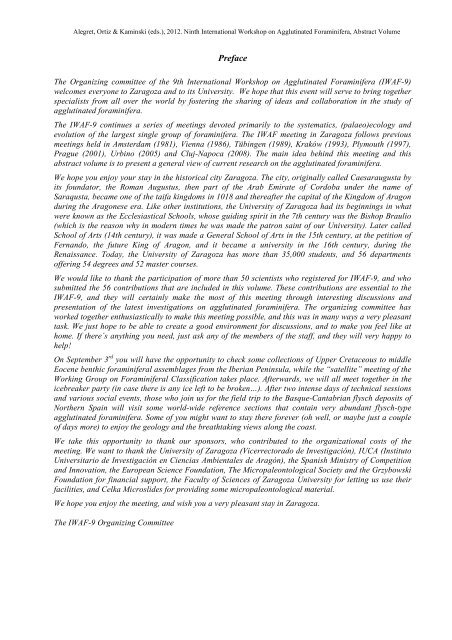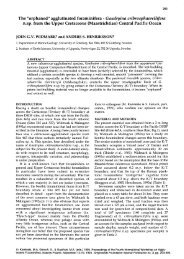Full Text | Download - Grzybowski Foundation - The ...
Full Text | Download - Grzybowski Foundation - The ...
Full Text | Download - Grzybowski Foundation - The ...
You also want an ePaper? Increase the reach of your titles
YUMPU automatically turns print PDFs into web optimized ePapers that Google loves.
Alegret, Ortiz & Kaminski (eds.), 2012. Ninth International Workshop on Agglutinated Foraminifera, Abstract Volume<br />
Preface<br />
<strong>The</strong> Organizing committee of the 9th International Workshop on Agglutinated Foraminifera (IWAF-9)<br />
welcomes everyone to Zaragoza and to its University. We hope that this event will serve to bring together<br />
specialists from all over the world by fostering the sharing of ideas and collaboration in the study of<br />
agglutinated foraminifera.<br />
<strong>The</strong> IWAF-9 continues a series of meetings devoted primarily to the systematics, (palaeo)ecology and<br />
evolution of the largest single group of foraminifera. <strong>The</strong> IWAF meeting in Zaragoza follows previous<br />
meetings held in Amsterdam (1981), Vienna (1986), Tübingen (1989), Kraków (1993), Plymouth (1997),<br />
Prague (2001), Urbino (2005) and Cluj-Napoca (2008). <strong>The</strong> main idea behind this meeting and this<br />
abstract volume is to present a general view of current research on the agglutinated foraminifera.<br />
We hope you enjoy your stay in the historical city Zaragoza. <strong>The</strong> city, originally called Caesaraugusta by<br />
its foundator, the Roman Augustus, then part of the Arab Emirate of Cordoba under the name of<br />
Saraqusta, became one of the taifa kingdoms in 1018 and thereafter the capital of the Kingdom of Aragon<br />
during the Aragonese era. Like other institutions, the University of Zaragoza had its beginnings in what<br />
were known as the Ecclesiastical Schools, whose guiding spirit in the 7th century was the Bishop Braulio<br />
(which is the reason why in modern times he was made the patron saint of our University). Later called<br />
School of Arts (14th century), it was made a General School of Arts in the 15th century, at the petition of<br />
Fernando, the future King of Aragon, and it became a university in the 16th century, during the<br />
Renaissance. Today, the University of Zaragoza has more than 35,000 students, and 56 departments<br />
offering 54 degrees and 52 master courses.<br />
We would like to thank the participation of more than 50 scientists who registered for IWAF-9, and who<br />
submitted the 56 contributions that are included in this volume. <strong>The</strong>se contributions are essential to the<br />
IWAF-9, and they will certainly make the most of this meeting through interesting discussions and<br />
presentation of the latest investigations on agglutinated foraminifera. <strong>The</strong> organizing committee has<br />
worked together enthusiastically to make this meeting possible, and this was in many ways a very pleasant<br />
task. We just hope to be able to create a good environment for discussions, and to make you feel like at<br />
home. If there´s anything you need, just ask any of the members of the staff, and they will very happy to<br />
help!<br />
On September 3 rd you will have the opportunity to check some collections of Upper Cretaceous to middle<br />
Eocene benthic foraminiferal assemblages from the Iberian Peninsula, while the “satellite” meeting of the<br />
Working Group on Foraminiferal Classification takes place. Afterwards, we will all meet together in the<br />
icebreaker party (in case there is any ice left to be broken…). After two intense days of technical sessions<br />
and various social events, those who join us for the field trip to the Basque-Cantabrian flysch deposits of<br />
Northern Spain will visit some world-wide reference sections that contain very abundant flysch-type<br />
agglutinated foraminifera. Some of you might want to stay there forever (oh well, or maybe just a couple<br />
of days more) to enjoy the geology and the breathtaking views along the coast.<br />
We take this opportunity to thank our sponsors, who contributed to the organizational costs of the<br />
meeting. We want to thank the University of Zaragoza (Vicerrectorado de Investigación), IUCA (Instituto<br />
Universitario de Investigación en Ciencias Ambientales de Aragón), the Spanish Ministry of Competition<br />
and Innovation, the European Science <strong>Foundation</strong>, <strong>The</strong> Micropaleontological Society and the <strong>Grzybowski</strong><br />
<strong>Foundation</strong> for financial support, the Faculty of Sciences of Zaragoza University for letting us use their<br />
facilities, and Celka Microslides for providing some micropaleontological material.<br />
We hope you enjoy the meeting, and wish you a very pleasant stay in Zaragoza.<br />
<strong>The</strong> IWAF-9 Organizing Committee



